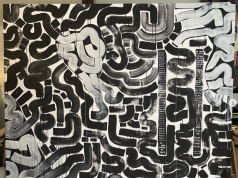Kafein’s K Project Space, Building an Alternative Film Archive By Nadia El-Dasher
The year 1957 saw the birth of Cairo’s first cinematheque in the city’s Downtown neighborhood. Their aim was to house a screening space and library of films under one roof – providing an archive of Egyptian films and as a result, inspiring a slew of young artists. Fifty eight years later, Cimatheque – Alternative Film Centre continues to do just that thanks to the tireless work of the late Abdel Hamid Said, film critic and former director of the Egyptian Cinema Organization. Cairo East Magazine talks to Cimatheque’s archivist, Yasmin Dessouki about Said’s role in Egypt’s film scene and the centre’s latest exhibit at Kafein’s K Project Space, Building an Alternative Film Archive.
CEM: How did you begin your journey with Cimatheque?
YD: I moved from New York to Cairo five years ago and started working at Misr International Films on the Youssef Chahine film archive. I started at Cimatheque in 2013 as an archivist, managing the film programming that we do.
What is Cimatheque’s library made up of?
We have press kits, film footage and different film reels – the majority of which was donated by Abdel Hamid Said. He was an important figure in Egyptian cinema for a number of decades and helped bring a lot of Arab cinema to the West. He was a writer and a self-made historian. When he passed away he donated his entire archive to Cimatheque.
How did Cimatheque’s archive come together?
There are a lot of people who have their own archives in Egypt. We got lucky in that when people knew we wanted to build a library they wanted to share their archives with the public through Cimatheque.
The items that make up the exhibit are displayed throughout the walls of Kafein – what made you select these particular pieces to showcase?
We have this very rich archive at Cimatheque and have been programming a lot of events around it – those at Kafein are all digital copies of certain elements that we have. We’re trying to get people interested in our archive to bring more awareness about it.
What instigated the collaboration with Kafein?
We began collaborating with Nadia and Dina, the owners of Kafein, for Dinner at the Movies (a monthly dinner and film screening held at Eish wi Malh) and it’s been going well. They approached me about doing an exhibit there based on our film archive and we agreed right away; the collaboration with them feels very natural.
How does the Building an Alternative Film Archive exhibit represent Cimatheque’s library?
In a way, we don’t see ourselves as taking the role of a central cinematheque per se. Our archive is built on a need, a sense of crisis as people have things and don’t know what to do with it, and so it isn’t heavily curated. It’s alternative in the way that the material is acquired as well as the kind of material it holds. It includes television commercials, official documents and actual film reels that represent a lot about our history and culture. It’s a modest enterprise but at the same time a very ambitious one.
Cimatheque’s venture may be humble but it’s influence can already be felt in the city’s film scene – with monthly dinner collaborations at Eish wi Malh and Building an Alternative Film Archive showing at Kafein until around the beginning of May.








